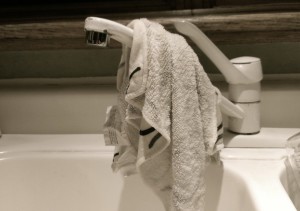Ever wonder how many microorganisms are on your scotch brite dish sponge or tea towels? Or how about that cutting board you used to cut the chicken for dinner? Whether wood or plastic, they can be washed in the dishawasher or cleaned with a dilute bleach solution. However, dish clothes and tea towels are another problem.
Bacteria in Wash Cloths and Tea Towels
The Sun recently wrote about a report by the Hygiene Council – a panel of the world’s leading microbiologists and virologists; revealing kitchen cloths and tea towels are the main culprits for harbouring and spreading bacteria. Shockingly, nine out of ten dish clothes are contaminated with bugs such as E.coli, salmonella and campylobacter – the bacteria that causes food poisoning.
How to Kill Bacteria on a Washcloth in Seconds?
Many people think they have to always just throw out their tea towels or dish cloth once they have been used to clean up a yucky spill or are smelling funky. Often when they start to smell you know there is a build up of bacteria.
The solution is really quite simple. According Dr. Joe Schwarcz, author of “Let them Eat Flax” (can find this book in Eco-Savy Store), wash clothes can be rid of microorganisms by putting a dry one in the microwave for thirty seconds or wet one for three minutes. The microwaves will kill all bacteria. HOW SIMPLE AND CONVENIENT IS THAT. What I like most about this is you don’t have to use any harmful chemicals and you will use less sponges in the long run, which is more sustainable.
It would be great to get feedback from our readers. What are your thoughts on bacteria and dishcloths? Have you ever heard of this technique to kill bacteria? What are you doing?


The idea is not new and can be very dangerous. Microwaving a dishcloth can result in a fire if the cloth becomes dry – not even the entire cloth, but an area dries. It will then continue to absorb microwave energy and become hot enough to ignite. The only things that should ever be put in a microwave oven are foods. I am a microwave scientist with over 50 years of experience with microwave ovens.
I thought I would comment on my own article because I have been getting a lot of the same feedback.
While yes it is true that one can use vinegar or lemon etc. to disinfect sponges, microwave reduces pathogens SIGNIFICANTLY MORE. For example a USDA Food Safety Laboratory in Beltsville MD (USA) compared sponges that were soaked in (1) 10% bleach solution for 3 minutes (2) lemon juice (ph 2.9) for 1 minute-note, this is similar to vinegar (3) de-ionized water for 1 minute (4) microwave for 1 min at full power (5) Placed in dishwasher for a full wash cycle and drying cycle and (6) control sample –untreated. They found microwaving and dish washing treatments significantly lowered the aerobic bacteria counts (1.6 log CFU/sponge) with very minimal variability (P<0.05) when compared to the treated sponge (i.e. lemon/vinegar soaked sponge) more than any chemical treatment or control (7.5 CFU/sponge). There study was so concrete that they even claimed that “the study shows that microwaving and dish washing treatments may kill foodborne pathogens in a household kitchen environment.”